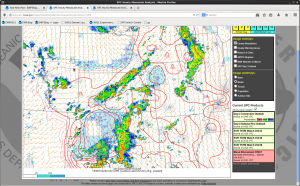Here is another set of images showing some shower development (there is no lightning).
2130Z CI product
2137Z Radar- not much to see, maybe “a” shower.
2145Z CI product- the highest probabilities have moved east
2147Z Radar.
2200 CI has increased in some areas. The yellow is over 60% while the green is 50%
2156Z radar is showing some shower developing
2215Z CI…still showing moderately high probabilities
2216 radar shows more showers
What is interesting about this example is that even when showers started showing up, even some that are near or above 35dbz, the CI is still picking up CI’s on it. This is likely because the CI product actually stops at a certain glaciation rate which is roughly equal to 35 dbz. So CI doesn’t “know” about the radar and the dbz levels. It just shows that even though CI may still be showing probabilities, there could still be something on radar.
Lauren13


























